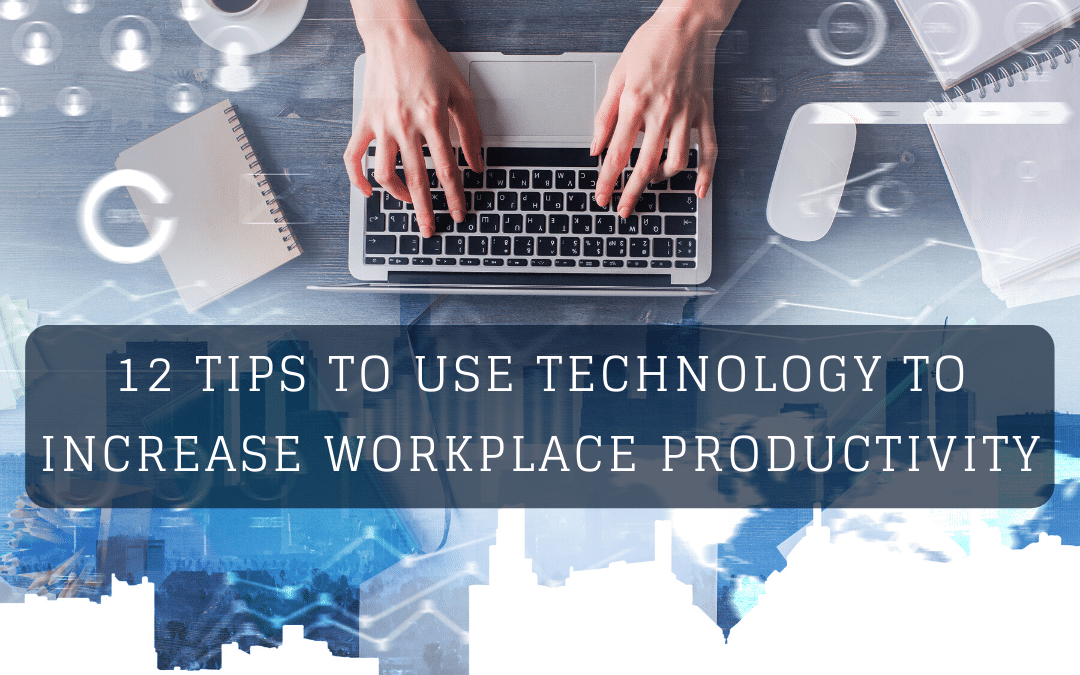Workplace productivity has been on the decline in the last decade. Here’s how you can implement technology to improve it.
Implementing modern technologies and digitalizing the workplace requires adequate examination and execution strategy. Companies should start by asking some basic general questions:
- Where’s the firm situated among its competitors?
- What’s the status of employees? Are they productive, motivated, and happy? If not, then why?
- Can new technologies be implemented? If yes, then which?
- Does existing software satisfy business needs? If not, then where to upgrade?
It’s not unusual for modern-day companies to use outdated methods and technologies. And because of their relative success, they never bothered to invest resources into evaluating and implementing modern tech. Said companies are losing business opportunities, time, and in the end, money due to the lack of digitalization.
Additionally, technologically lagging behind other companies might prove fatal as time passes. Not evaluating and updating might produce a gap too big to cover when the economic situation changes or when peculiar circumstances arrive. The world is continually evolving, and business people must follow.
The objective is to reduce costs, time, and resources to produce superior products and services. Therefore, constant evaluation and improvement are necessary.
In this article, we’ll be looking at a quick rundown of fundamental principles for increasing workplace productivity through technology that’s accessible and relatively cheap. It’s just as important to know when and how to use technology in the workplace:
Could your real estate business use more sales revenue? Blitz can help to nurture relationships and win more customers with our easy and effective sales follow up software! Schedule a free demo with us and we’ll show you how our software can increase efficiency and improve sales at your company!
1. Anonymous employee feedback
The first logical way of improving workplace productivity is by starting with the employees. They’re the heartbeat of the business, and it’s almost certain they’ll provide valuable input—the only problem is human insecurity. People are often shy and hesitant when asked to be brutally honest. It can prove somewhat tricky to get a sincere and detailed opinion of a worker face-to-face. The best solution is to guarantee anonymity through dedicated software. According to a Gallup study, employee feedback generated 8.9% greater profitability.
Sure, the strategy isn’t entirely new, paper note boxes existed way before computers but didn’t ensure anonymity as workers were still required to handwrite. If the subjects get the smallest hint of possible personal repercussions, then the result can’t be considered exact. It’s vital to guarantee complete anonymity through dedicated e-mail inboxes, surveys, and similar software solutions. This way, employers will have a higher chance of reporting ineffective or even damaging issues within the firm. By identifying and resolving serious issues, profitability will ultimately increase.
For example, Engagedly, 6Q, TinyPulse, Subcurrent, and even Microsoft Word 365 can create anonymous surveys.
2. Business applications
Companies should ensure that employees have facilitated direct access to fundamental business applications such as:
- Customer Relationship Management (CRM);
- Enterprise resource planning (ERP);
- Human Resources (HR);
- Help Desks and Wikis;
- Accounting & Payroll;
- Contract management.
A study by Apperian reveals that 23% of workers observe increased workplace productivity when using mobile applications. Depending on the industry, other apps might apply. The idea is to reduce manual labor as much as possible and increase digitalization for basic company necessities.
Customer Relationship Management (CRM) is particularly important as it pertains to clients. Although the rest of the applications are important, they don’t affect profitability directly. Every business should maximize attention to customers as it’s one of the fundamental ways to add value to most saturated markets. Applications such as Blitz’s mobile app combine facilitated mobile use with state-of-the-art features regarding CRM.

3. Messaging
Firms must ensure fast and reliable ways of messaging. Every employee should have expedited access to work channels at all times. According to The Wireless Industry Data by CTIA, 89% of people have their smartphones readily available. Instant voice recording or chatting seems to be the most practical way, compatible with most devices and smartphones, with customizable alerts so as not to stress the worker in his leisure time.
Readily-available apps include Slack, HipChat, Basecamp, DialMyCalls, RedBooth, Wrike, Skype, FlowDock, and Azendoo.
4. Communication
Information sharing is a central component of life, not only for improving workplace productivity. Team managers must continuously improve communication methods through oriented digitalization:
- Portals and intranet with less lag and delays;
- Cloud-services for remote access;
- Customer service chatbots;
- Stable video conferencing;
- Online group meetings with integrated tools and whiteboards;
- Voice over IP (VOIP) systems with call routing, faxing, and voicemail.
Citing the Society for Human Resource Management, companies with under 100 employees lose roughly $420,000 a year due to inefficient communication.
5. Individual productivity
One of the most evident approaches in which technology can increase workplace productivity is through each employee. There are few routes in which a business can control or increase the productivity of individuals in the workplace through dedicated software:
- Time tracking apps will monitor the effective work time by capturing the screen every few seconds;
- Focus software will block access to irrelevant websites such as social media, entertainment sites, and similar;
- Ad blockers will prevent ads from appearing when surfing the internet, reducing research delay.
Although monitoring strategies might prove very efficient in increasing workplace productivity and controlling individual work progress, it’s vital not to constrain the worker’s creativity and thought process. Overreaching surveillance methods or deploying them in inappropriate cases can prove stressful to the worker and, by extension, harm the company in the long run. The American Insitute of Stress estimated that US businesses lose up to $300 billion annually due to workplace stress.
Increase the effectiveness of your sales and marketing efforts at your real estate company with our easy-to-use follow up software! Blitz is reasonably priced, and is packed with the tools your real estate agency needs! Contact us to learn more!
6. Employee appreciation and acknowledgment
Speaking of employees, companies should never underestimate the power of gratitude. According to a Canadian Incentive and Rewards Trends Study, 60% of Canadians aren’t motivated by their employer’s rewards plan.
Workers that are shown public recognition, even on social media, are bound to increase workplace productivity, morale, and the overall well-being of the company. The concept is similar to “employee of the month.” But instead of hanging a photo in some forgotten corner of an office, the attention is given publicly. Sure, a raise now and then might also potentiate the results—give, and you shall receive.
Other rewards might include gifts, shopping cards, and free company products. The idea is to give small but regular treats. This way, the worker is constantly motivated. It’s also advisable to include a human component. Don’t just send the gift through the mail, but ask a higher-up to deliver it in person.
7. Telecommuting or working from home (WFH)
Businesses who engage in teleworking are experiencing economic benefits across the board:
- Reduced work and health insurance costs;
- Employees are more productive and happier;
- Reduced rent, lighting, and climate control costs;
- The increased ecological value of the firm;
- Home sourced workers are usually more cost-effective;
- Possible tax benefits.
Citing a PGi Telework Week survey, 82% of telecommuters are less stressed, 80% have higher morale, and 69% missed fewer workdays. A valid starting outline for implementing teleworking would consist of four elements:
- Enhancing communication: Slack, TeamViewer, Zoom, and Uber Conference;
- Coordinating teams: Google Hangouts, Google Drive, Dropbox, and Taskworld;
- Streamlining project management: Hubstaff, Trello, Asana, and Harvest;
- Scheduling and task completion: Calendly, Todoist, and iDoneThis.
Companies must simulate an office in the worker’s home. Consider what other features exist at work that a typical house doesn’t have.

8. Targeted ads and custom marketing
Instead of spending substantial sums of money on massive ad campaigns, consider switching to targeting ads through industry-leading companies such as Facebook and Google. The system creates an accurate socio-economic profile of the potential buyer and directs customized push notifications that fit his description and interests. Custom marketing increases the click-through rate (CTR) and reduces waste. A survey by AboutAds concluded that 40.5% of users prefer seeing targeted ads when surfing the web.
9. Mobile-friendly workplace
Businesses should consider the Bring Your Own Device (BYOD) policy and allow personal smartphones at work. This doesn’t mean a worker should play video games or make phone calls every 5 minutes, but use his own devices to increase performance and energy cost-efficiency. According to Fliplet research, the BYOD strategy generates an extra 240 work hours or the equivalent of $5114 per employee yearly.
BYOD policy saves the cost of buying and replacing devices. It reduces energy expenses and internet bandwidth usage. Additionally, it also improves efficiency as the operator is already familiarized with his device.
10. Workflow automation and flowchart diagrams
Providing workers with a task outline might speed up the process and achieve better results. The hardest part of a profession isn’t the job itself but having the right perspective and organization. A McKinsey study showed how 60% of trades could save time up to 30% with workflow automation.
Blitz is an IT company that offers highly customizable workflow integration from scratch. There’s virtually no business than can’t be segmented into a flowchart. Experts and managers can advise on how to proceed towards workflow automation which will undoubtedly result in better practices and workplace productivity.
11. Self-service
Making resources available and encouraging autonomy is sure to provide positive results. Cut the middle man and allow your business the freedom to use readily available tools and information. A report from VMware found that 54% of Chief Intelligence Officers (CIOs) observed faster work rates when business applications were easily accessible.
In order of relevance, consider the following applications: Google Docs and Google Drive, Box for Business, Confluence, Intranet Connections, Igloo, Alfresco, Samepage, Huddle, Liferay Social Office, Nuxeo, Jostle.me, Wix, Process Street, Redbooth, ONLYOFFICE, Podio, Papertrail, Dokmee, and Webmerge.
12. Expert company audit
Finally, a company should always ask for professional evaluation and counseling after improving locally through internal investigation and implementation. An expert’s opinion might reveal additional room for improvement.
Final thought
The United States Bureau of Labor Statistics underlined an interesting counterintuitive trend: employee workplace productivity has been steadily declining in the last decade. The rise of new technologies has propagated the idea that workers should do more, often resulting in overloading, stress, and burnout. In such cases, employee workplace productivity has decreased dramatically, despite the introduction of digitalization. Consequently, it’s vital to know where and how to implement new strategies.
So be careful, ensure that your workers are comfortable, and your business will flourish in the age of digitalization.
Increase the effectiveness of your sales and marketing efforts at your real estate company with our easy-to-use follow up software! Blitz is reasonably priced, and is packed with the tools your real estate agency needs! Contact us to learn more!

Leon Collier
Guest Author
Leon Collier is a British blogger writer at dissertation help, who enjoys writing about education, history, pop-culture, traveling, marketing, personal development, and everything in-between. In his free time, you’ll find him delving in a pile of books.


nice post
Thank you so much for this wonderful Post and all the best for your future. I hope to see more post from you. I am satisfied with the arrangement of your post. You are really a talented person I have ever seen
All of these tips are amazing. I’ve never read before any blog.
we are referring largely to how much work is accomplished in a particular work environment
To follow flow chat as a professional business tool is very easy to understand as a worker and as a business consultant, everyone should follow this. you shared such a good post keep going
These are amazing tips
Thank you for sharing this wonderful tips on how to use technology, very helpful and detailed.
By reading this article I get a lot of lessons and this is very useful.
According to one study, adopting mobile applications and software solutions enhanced productivity for 23% of the workers that used them.
Its important to make your work environment productive
I pretty much love everything about this–nice job!